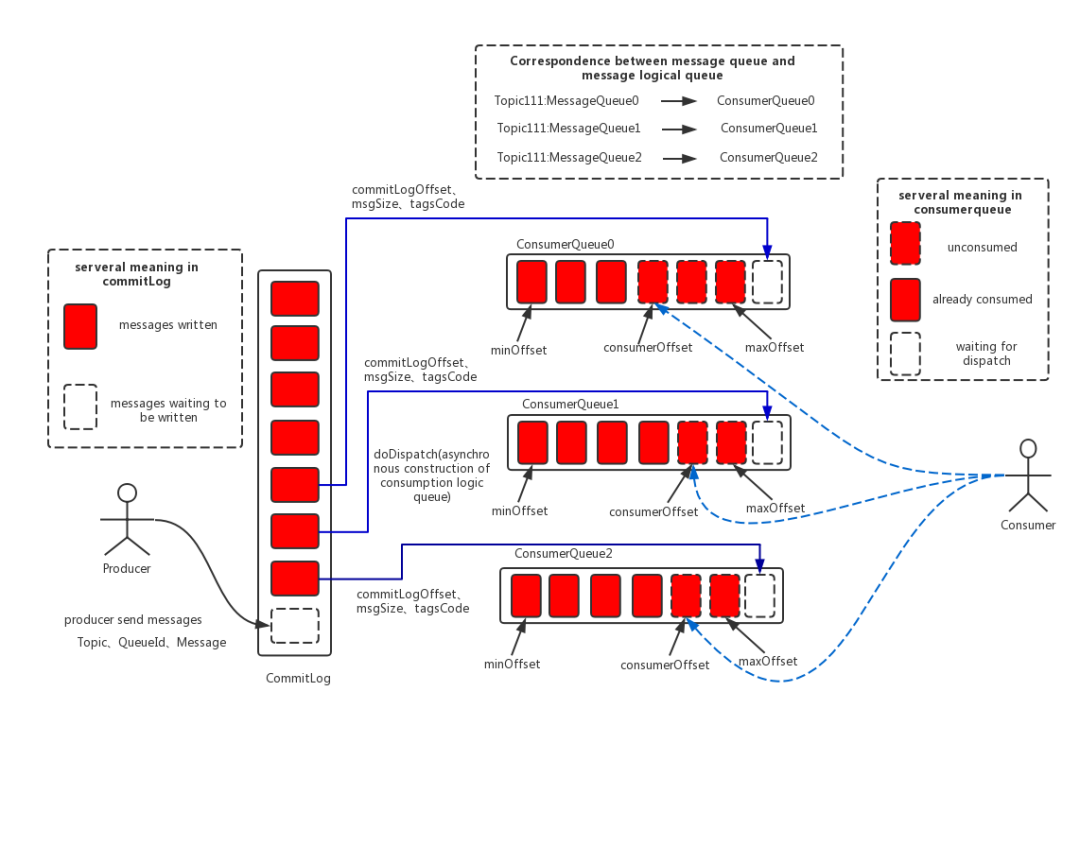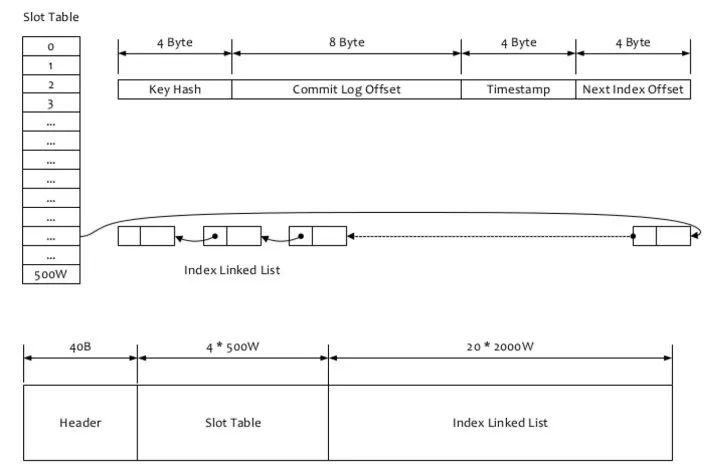RocketMQ(十):数据存储模型的设计与实现
消息中间件,说是一个通信组件也没有错,因为它的本职工作是做消息的传递。然而要做到高效的消息传递,很重要的一点是数据结构,数据结构设计的好坏,一定程度上决定了该消息组件的性能以及能力上限。
1. 消息中间件的实现方式概述
消息中间件实现起来自然是很难的,但我们可以从某些角度,简单了说说实现思路。
它的最基本的两个功能接口为:接收消息的发送(produce), 消息的消费(consume). 就像一个邮递员一样,经过它与不经过它实质性的东西没有变化,它只是一个中介(其他功能效应,咱们抛却不说)。
为了实现这两个基本的接口,我们就得实现两个最基本的能力:消息的存储和查询。存储即是接收发送过来的消息,查询则包括业务查询与系统自行查询推送。
我们先来看第一个点:消息的存储。
直接基于内存的消息组件,可以做到非常高效的传递,基本上此时的消息中间件就是由几个内存队列组成,只要保证这几个队列的安全性和实时性,就可以工作得很好了。然而基于内存则必然意味着能力有限或者成本相当高,所以这样的设计适用范围得结合业务现状做下比对。
另一个就是基于磁盘的消息组件,磁盘往往意味着更大的存储空间,或者某种程度上意味着无限的存储空间,因为毕竟所有的大数据都是存放在磁盘上的,前提是系统需要协调好各磁盘间的数据关系。然而,磁盘也意味着性能的下降,数据存放起来更麻烦。但rocketmq借助于操作系统的pagecache和mmap以及顺序写机制,在读写性能方面已经非常优化。所以,更重要的是如何设计好磁盘的数据据结构。
然后是第二个点:消息的查询。
具体如何查询,则必然依赖于如何存储,与上面的原理类似,不必细说。但一般会有两种消费模型:推送消息模型和拉取消费模型。即是消息中间件主动向消费者推送消息,或者是消费者主动查询消息中间件。二者也各有优劣,推送模型一般可以体现出更强的实时性以及保持比较小的server端存储空间占用,但是也带来了非常大的复杂度,它需要处理各种消费异常、重试、负载均衡、上下线,这不是件小事。而拉取模型则会对消息中间件减轻许多工作,主要是省去了异常、重试、负载均衡类的工作,将这些工作转嫁到消费者客户端上。但与此同时,也会对消息中间件提出更多要求,即要求能够保留足够长时间的数据,以便所有合法的消费者都可以进行消费。而对于客户端,则也需要中间件提供相应的便利,以便可以实现客户端的基本诉求,比如消费组管理,上下线管理以及最基本的高效查询能力。
2. rocketmq存储模型设计概述
很明显,rocketmq的初衷就是要应对大数据的消息传递,所以其必然是基于磁盘的存储。而其性能如上节所述,其利用操作系统的pagecache和mmap机制,读写性能非常好,另外他使用顺序写机制,使普通磁盘也能体现出非常高的性能。
但是,以上几项,只是为高性能提供了必要的前提。但具体如何利用,还需要从重设计。毕竟,快不是目的,实现需求才是意义。
rocketmq中主要有四种存储文件:commitlog 数据文件, consumequeue 消费队列文件, index 索引文件, 元数据信息文件。最后一个元数据信息文件比较简单,因其数据量小,方便操作。但针对前三个文件,都会涉及大量的数据问题,所以必然好详细设计其结构。
从总体上来说,rocketmq都遵从定长数据结构存储,定长的最大好处就在于可以快速定位位置,这是其高性能的出发点。定长模型。
从核心上来说,commitlog文件保存了所有原始数据,所有数据想要获取,都能从或也只能从commitlog文件中获取,由于commitlog文件保持了顺序写的特性,所以其性能非常高。而因数据只有一份,所以也就从根本上保证了数据一致性。
而根据各业务场景,衍生出了consumequeue和index文件,即 consumequeue 文件是为了消费者能够快速获取到相应消息而设计,而index文件则为了能够快速搜索到消息而设计。从功能上说,consumequeue和index文件都是索引文件,只是索引的维度不同。consumequeue 是以topic和queueId维度进行划分的索引,而index 则是以时间和key作为划分的索引。有了这两个索引之后,就可以为各自的业务场景,提供高性能的服务了。具体其如何实现索引,我们稍后再讲!
commitlog vs consumequeue 的存储模型如下:

3. commitlog文件的存储结构
直接顺序写的形式存储,每个文件设定固定大小,默认是1G即: 1073741824 bytes. 写满一个文件后,新开一个文件写入。文件名就是其存储的起始消息偏移量。
官方描述如下:
CommitLog:消息主体以及元数据的存储主体,存储Producer端写入的消息主体内容,消息内容不是定长的。单个文件大小默认1G ,文件名长度为20位,左边补零,剩余为起始偏移量,比如00000000000000000000代表了第一个文件,起始偏移量为0,文件大小为1G=1073741824;当第一个文件写满了,第二个文件为00000000001073741824,起始偏移量为1073741824,以此类推。消息主要是顺序写入日志文件,当文件满了,写入下一个文件;
当给定一个偏移量,要查找某条消息时,只需在所有的commitlog文件中,根据其名字即可知道偏移的数据信息是否存在其中,即相当于可基于文件实现一个二分查找,实际上rocketmq实现得更简洁,直接一次性查找即可定位:
// org.apache.rocketmq.store.CommitLog#getDatapublic SelectMappedBufferResult getData(final long offset, final boolean returnFirstOnNotFound) {int mappedFileSize = this.defaultMessageStore.getMessageStoreConfig().getMappedFileSizeCommitLog();// 1. 先在所有commitlog文件中查找到对应所在的 commitlog 分片文件MappedFile mappedFile = this.mappedFileQueue.findMappedFileByOffset(offset, returnFirstOnNotFound);if (mappedFile != null) {// 再从该分片文件中,移动余数的大小偏移,即可定位到要查找的消息记录了int pos = (int) (offset % mappedFileSize);SelectMappedBufferResult result = mappedFile.selectMappedBuffer(pos);return result;}return null;}// 查找偏移所在commitlog文件的实现方式:// org.apache.rocketmq.store.MappedFileQueue#findMappedFileByOffset(long, boolean)// firstMappedFile.getFileFromOffset() / this.mappedFileSize 代表了第一条记录所处的文件位置编号// offset / this.mappedFileSize 代表当前offset所处的文件编号// 那么,两个编号相减就是当前offset对应的文件编号,因为第一个文件编号的相对位置是0// 但有个前提:就是每个文件存储的大小必须是真实的对应的 offset 大小之差,而实际上consumeQueue根本无法确定它存了多少offset// 也就是说,只要文件定长,offset用于定位 commitlog文件就是合理的int index = (int) ((offset / this.mappedFileSize) - (firstMappedFile.getFileFromOffset() / this.mappedFileSize));MappedFile targetFile = null;try {// 所以,此处可以找到 commitlog 文件对应的 mappedFiletargetFile = this.mappedFiles.get(index);} catch (Exception ignored) {}if (targetFile != null && offset >= targetFile.getFileFromOffset()&& offset < targetFile.getFileFromOffset() + this.mappedFileSize) {return targetFile;}// 如果快速查找失败,则退回到遍历方式, 使用O(n)的复杂度再查找一次for (MappedFile tmpMappedFile : this.mappedFiles) {if (offset >= tmpMappedFile.getFileFromOffset()&& offset < tmpMappedFile.getFileFromOffset() + this.mappedFileSize) {return tmpMappedFile;}}
定位到具体的消息记录位置后,如何知道要读多少数据呢?这实际上在commitlog的数据第1个字节中标明,只需读出即可知道。
具体commitlog的存储实现如下:
// org.apache.rocketmq.store.CommitLog.DefaultAppendMessageCallback#doAppend...// Initialization of storage spacethis.resetByteBuffer(msgStoreItemMemory, msgLen);// 1 TOTALSIZE, 首先将消息大小写入this.msgStoreItemMemory.putInt(msgLen);// 2 MAGICCODEthis.msgStoreItemMemory.putInt(CommitLog.MESSAGE_MAGIC_CODE);// 3 BODYCRCthis.msgStoreItemMemory.putInt(msgInner.getBodyCRC());// 4 QUEUEIDthis.msgStoreItemMemory.putInt(msgInner.getQueueId());// 5 FLAGthis.msgStoreItemMemory.putInt(msgInner.getFlag());// 6 QUEUEOFFSETthis.msgStoreItemMemory.putLong(queueOffset);// 7 PHYSICALOFFSETthis.msgStoreItemMemory.putLong(fileFromOffset + byteBuffer.position());// 8 SYSFLAGthis.msgStoreItemMemory.putInt(msgInner.getSysFlag());// 9 BORNTIMESTAMPthis.msgStoreItemMemory.putLong(msgInner.getBornTimestamp());// 10 BORNHOSTthis.resetByteBuffer(bornHostHolder, bornHostLength);this.msgStoreItemMemory.put(msgInner.getBornHostBytes(bornHostHolder));// 11 STORETIMESTAMPthis.msgStoreItemMemory.putLong(msgInner.getStoreTimestamp());// 12 STOREHOSTADDRESSthis.resetByteBuffer(storeHostHolder, storeHostLength);this.msgStoreItemMemory.put(msgInner.getStoreHostBytes(storeHostHolder));// 13 RECONSUMETIMESthis.msgStoreItemMemory.putInt(msgInner.getReconsumeTimes());// 14 Prepared Transaction Offsetthis.msgStoreItemMemory.putLong(msgInner.getPreparedTransactionOffset());// 15 BODYthis.msgStoreItemMemory.putInt(bodyLength);if (bodyLength > 0)this.msgStoreItemMemory.put(msgInner.getBody());// 16 TOPICthis.msgStoreItemMemory.put((byte) topicLength);this.msgStoreItemMemory.put(topicData);// 17 PROPERTIESthis.msgStoreItemMemory.putShort((short) propertiesLength);if (propertiesLength > 0)this.msgStoreItemMemory.put(propertiesData);final long beginTimeMills = CommitLog.this.defaultMessageStore.now();// Write messages to the queue bufferbyteBuffer.put(this.msgStoreItemMemory.array(), 0, msgLen);...
可以看出,commitlog的存储还是比较简单的,因为其主要就是负责将接收到的所有消息,依次写入同一文件中。因为专一所以专业。
4. consumequeue文件的存储结构
consumequeue作为消费者的重要依据,同样起着非常重要的作用。消费者在进行消费时,会使用一些偏移量作为依据(拉取模型实现)。而这些个偏移量,实际上就是指的consumequeue的偏移量(注意不是commitlog的偏移量)。这样做有什么好处呢?首先,consumequeue作为索引文件,它被要求要有非常高的查询性能,所以越简单越好。最好是能够一次性定位到数据!
如果想一次性定位数据,那么唯一的办法是直接使用commitlog的offset。但这会带来一个最大的问题,就是当我当前消息消费拉取完成后,下一条消息在哪里呢?如果单靠commitlog文件,那么,它必然需要将下一条消息读入,然后再根据topic判定是不是需要的数据。如此一来,就必然存在大量的commitlog文件的io问题了。所以,这看起来是非常快速的一个解决方案,最终又变成了非常费力的方案了。
而使用commitlog文件的offset,则好了许多。因为consumequeue的文件存储格式是一条消息占20字节,即定长。根据这20字节,你可以找到commitlog的offset. 而因为consumequeue本身就是按照topic/queueId进行划分的,所以,本次消费完成后,下一次消费的数据必定就在consumequeue的下一位置。如此简单快速搞得定了。具体consume的存储格式,如官方描述:
ConsumeQueue:消息消费队列,引入的目的主要是提高消息消费的性能,由于RocketMQ是基于主题topic的订阅模式,消息消费是针对主题进行的,如果要遍历commitlog文件中根据topic检索消息是非常低效的。Consumer即可根据ConsumeQueue来查找待消费的消息。其中,ConsumeQueue(逻辑消费队列)作为消费消息的索引,保存了指定Topic下的队列消息在CommitLog中的起始物理偏移量offset,消息大小size和消息Tag的HashCode值。consumequeue文件可以看成是基于topic的commitlog索引文件,故consumequeue文件夹的组织方式如下:topic/queue/file三层组织结构,具体存储路径为:$HOME/store/consumequeue/{topic}/{queueId}/{fileName}。同样consumequeue文件采取定长设计,每一个条目共20个字节,分别为8字节的commitlog物理偏移量、4字节的消息长度、8字节tag hashcode,单个文件由30W个条目组成,可以像数组一样随机访问每一个条目,每个ConsumeQueue文件大小约5.72M;
其中fileName也是以偏移量作为命名依据,因为这样才能根据offset快速查找到数据所在的分片文件。
其存储实现如下:
// org.apache.rocketmq.store.ConsumeQueue#putMessagePositionInfoprivate boolean putMessagePositionInfo(final long offset, final int size, final long tagsCode,final long cqOffset) {if (offset + size <= this.maxPhysicOffset) {log.warn("Maybe try to build consume queue repeatedly maxPhysicOffset={} phyOffset={}", maxPhysicOffset, offset);return true;}// 依次写入 offset + size + tagsCodethis.byteBufferIndex.flip();this.byteBufferIndex.limit(CQ_STORE_UNIT_SIZE);this.byteBufferIndex.putLong(offset);this.byteBufferIndex.putInt(size);this.byteBufferIndex.putLong(tagsCode);final long expectLogicOffset = cqOffset * CQ_STORE_UNIT_SIZE;MappedFile mappedFile = this.mappedFileQueue.getLastMappedFile(expectLogicOffset);if (mappedFile != null) {if (mappedFile.isFirstCreateInQueue() && cqOffset != 0 && mappedFile.getWrotePosition() == 0) {this.minLogicOffset = expectLogicOffset;this.mappedFileQueue.setFlushedWhere(expectLogicOffset);this.mappedFileQueue.setCommittedWhere(expectLogicOffset);this.fillPreBlank(mappedFile, expectLogicOffset);log.info("fill pre blank space " + mappedFile.getFileName() + " " + expectLogicOffset + " "+ mappedFile.getWrotePosition());}if (cqOffset != 0) {long currentLogicOffset = mappedFile.getWrotePosition() + mappedFile.getFileFromOffset();if (expectLogicOffset < currentLogicOffset) {log.warn("Build consume queue repeatedly, expectLogicOffset: {} currentLogicOffset: {} Topic: {} QID: {} Diff: {}",expectLogicOffset, currentLogicOffset, this.topic, this.queueId, expectLogicOffset - currentLogicOffset);return true;}if (expectLogicOffset != currentLogicOffset) {LOG_ERROR.warn("[BUG]logic queue order maybe wrong, expectLogicOffset: {} currentLogicOffset: {} Topic: {} QID: {} Diff: {}",expectLogicOffset,currentLogicOffset,this.topic,this.queueId,expectLogicOffset - currentLogicOffset);}}this.maxPhysicOffset = offset + size;// 将buffer写入 consumequeue 的 mappedFile 中return mappedFile.appendMessage(this.byteBufferIndex.array());}return false;}当需要进行查找进,也就会根据offset, 定位到某个 consumequeue 文件,然后再根据偏移余数信息,再找到对应记录,取出20字节,即是 commitlog信息。此处实现与 commitlog 的offset查找实现如出一辙。// 查找索引所在文件的实现,如下:// org.apache.rocketmq.store.ConsumeQueue#getIndexBufferpublic SelectMappedBufferResult getIndexBuffer(final long startIndex) {int mappedFileSize = this.mappedFileSize;// 给到客户端的偏移量是除以 20 之后的,也就是说 如果上一次的偏移量是 1, 那么下一次的偏移量应该是2// 一次性消费多条记录另算, 自行加减long offset = startIndex * CQ_STORE_UNIT_SIZE;if (offset >= this.getMinLogicOffset()) {// 委托给mappedFileQueue进行查找到单个具体的consumequeue文件// 根据 offset 和规范的命名,可以快速定位分片文件,如上 commitlog 的查找实现MappedFile mappedFile = this.mappedFileQueue.findMappedFileByOffset(offset);if (mappedFile != null) {// 再根据剩余的偏移量,直接类似于数组下标的形式,一次性定位到具体的数据记录SelectMappedBufferResult result = mappedFile.selectMappedBuffer((int) (offset % mappedFileSize));return result;}}return null;}
如果想一次性消费多条消息,则只需要依次从查找到索引记录开始,依次读取多条,然后同理回查commitlog即可。即consumequeue的连续,成就了commitlog的不连续。如下消息拉取实现:
// org.apache.rocketmq.store.DefaultMessageStore#getMessage// 其中 bufferConsumeQueue 是刚刚查找出的consumequeue的起始消费位置// 基于此文件迭代,完成多消息记录消费...long nextPhyFileStartOffset = Long.MIN_VALUE;long maxPhyOffsetPulling = 0;int i = 0;final int maxFilterMessageCount = Math.max(16000, maxMsgNums * ConsumeQueue.CQ_STORE_UNIT_SIZE);final boolean diskFallRecorded = this.messageStoreConfig.isDiskFallRecorded();ConsumeQueueExt.CqExtUnit cqExtUnit = new ConsumeQueueExt.CqExtUnit();for (; i < bufferConsumeQueue.getSize() && i < maxFilterMessageCount; i += ConsumeQueue.CQ_STORE_UNIT_SIZE) {// 依次取出commitlog的偏移量,数据大小,hashCode// 一次循环即是取走一条记录,多次循环则依次往下读取long offsetPy = bufferConsumeQueue.getByteBuffer().getLong();int sizePy = bufferConsumeQueue.getByteBuffer().getInt();long tagsCode = bufferConsumeQueue.getByteBuffer().getLong();maxPhyOffsetPulling = offsetPy;if (nextPhyFileStartOffset != Long.MIN_VALUE) {if (offsetPy < nextPhyFileStartOffset)continue;}boolean isInDisk = checkInDiskByCommitOffset(offsetPy, maxOffsetPy);if (this.isTheBatchFull(sizePy, maxMsgNums, getResult.getBufferTotalSize(), getResult.getMessageCount(),isInDisk)) {break;}boolean extRet = false, isTagsCodeLegal = true;if (consumeQueue.isExtAddr(tagsCode)) {extRet = consumeQueue.getExt(tagsCode, cqExtUnit);if (extRet) {tagsCode = cqExtUnit.getTagsCode();} else {// can't find ext content.Client will filter messages by tag also.log.error("[BUG] can't find consume queue extend file content!addr={}, offsetPy={}, sizePy={}, topic={}, group={}",tagsCode, offsetPy, sizePy, topic, group);isTagsCodeLegal = false;}}if (messageFilter != null&& !messageFilter.isMatchedByConsumeQueue(isTagsCodeLegal ? tagsCode : null, extRet ? cqExtUnit : null)) {if (getResult.getBufferTotalSize() == 0) {status = GetMessageStatus.NO_MATCHED_MESSAGE;}continue;}SelectMappedBufferResult selectResult = this.commitLog.getMessage(offsetPy, sizePy);if (null == selectResult) {if (getResult.getBufferTotalSize() == 0) {status = GetMessageStatus.MESSAGE_WAS_REMOVING;}nextPhyFileStartOffset = this.commitLog.rollNextFile(offsetPy);continue;}if (messageFilter != null&& !messageFilter.isMatchedByCommitLog(selectResult.getByteBuffer().slice(), null)) {if (getResult.getBufferTotalSize() == 0) {status = GetMessageStatus.NO_MATCHED_MESSAGE;}// release...selectResult.release();continue;}this.storeStatsService.getGetMessageTransferedMsgCount().incrementAndGet();getResult.addMessage(selectResult);status = GetMessageStatus.FOUND;nextPhyFileStartOffset = Long.MIN_VALUE;}if (diskFallRecorded) {long fallBehind = maxOffsetPy - maxPhyOffsetPulling;brokerStatsManager.recordDiskFallBehindSize(group, topic, queueId, fallBehind);}// 分配下一次读取的offset偏移信息,同样要除以单条索引大小nextBeginOffset = offset + (i / ConsumeQueue.CQ_STORE_UNIT_SIZE);long diff = maxOffsetPy - maxPhyOffsetPulling;long memory = (long) (StoreUtil.TOTAL_PHYSICAL_MEMORY_SIZE* (this.messageStoreConfig.getAccessMessageInMemoryMaxRatio() / 100.0));getResult.setSuggestPullingFromSlave(diff > memory);...
以上即理论的实现,无须多言。
5. index文件的存储结构
index文件是为搜索场景而生的,如果没有搜索业务需求,则这个实现是意义不大的。一般这种搜索,主要用于后台查询验证类使用,或者有其他同的有妙用,不得而知。总之,一切为搜索。它更多的需要借助于时间限定,以key或者id进行查询。
官方描述如下:
IndexFile(索引文件)提供了一种可以通过key或时间区间来查询消息的方法。Index文件的存储位置是:$HOME \store\index\${fileName},文件名fileName是以创建时的时间戳命名的,固定的单个IndexFile文件大小约为400M,一个IndexFile可以保存 2000W个索引,IndexFile的底层存储设计为在文件系统中实现HashMap结构,故rocketmq的索引文件其底层实现为hash索引。
IndexFile索引文件为用户提供通过“按照Message Key查询消息”的消息索引查询服务,IndexFile文件的存储位置是:$HOME\store\index\${fileName},文件名fileName是以创建时的时间戳命名的,文件大小是固定的,等于40+500W\*4+2000W\*20= 420000040个字节大小。如果消息的properties中设置了UNIQ_KEY这个属性,就用 topic + “#” + UNIQ_KEY的value作为 key 来做写入操作。如果消息设置了KEYS属性(多个KEY以空格分隔),也会用 topic + “#” + KEY 来做索引。
其中的索引数据包含了Key Hash/CommitLog Offset/Timestamp/NextIndex offset 这四个字段,一共20 Byte。NextIndex offset 即前面读出来的 slotValue,如果有 hash冲突,就可以用这个字段将所有冲突的索引用链表的方式串起来了。Timestamp记录的是消息storeTimestamp之间的差,并不是一个绝对的时间。整个Index File的结构如图,40 Byte 的Header用于保存一些总的统计信息,4\*500W的 Slot Table并不保存真正的索引数据,而是保存每个槽位对应的单向链表的头。20\*2000W 是真正的索引数据,即一个 Index File 可以保存 2000W个索引。
具体结构图如下:

那么,如果要查找一个key, 应当如何查找呢?rocketmq会根据时间段找到一个index索引分版,然后再根据key做hash得到一个值,然后定位到 slotValue . 然后再从slotValue去取出索引数据的地址,找到索引数据,然后再回查 commitlog 文件。从而得到具体的消息数据。也就是,相当于搜索经历了四级查询:索引分片文件查询 -> slotValue 查询 -> 索引数据查询 -> commitlog 查询 。
具体查找实现如下:
// org.apache.rocketmq.broker.processor.QueryMessageProcessor#queryMessagepublic RemotingCommand queryMessage(ChannelHandlerContext ctx, RemotingCommand request)throws RemotingCommandException {final RemotingCommand response =RemotingCommand.createResponseCommand(QueryMessageResponseHeader.class);final QueryMessageResponseHeader responseHeader =(QueryMessageResponseHeader) response.readCustomHeader();final QueryMessageRequestHeader requestHeader =(QueryMessageRequestHeader) request.decodeCommandCustomHeader(QueryMessageRequestHeader.class);response.setOpaque(request.getOpaque());String isUniqueKey = request.getExtFields().get(MixAll.UNIQUE_MSG_QUERY_FLAG);if (isUniqueKey != null && isUniqueKey.equals("true")) {requestHeader.setMaxNum(this.brokerController.getMessageStoreConfig().getDefaultQueryMaxNum());}// 从索引文件中查询消息final QueryMessageResult queryMessageResult =this.brokerController.getMessageStore().queryMessage(requestHeader.getTopic(),requestHeader.getKey(), requestHeader.getMaxNum(), requestHeader.getBeginTimestamp(),requestHeader.getEndTimestamp());assert queryMessageResult != null;responseHeader.setIndexLastUpdatePhyoffset(queryMessageResult.getIndexLastUpdatePhyoffset());responseHeader.setIndexLastUpdateTimestamp(queryMessageResult.getIndexLastUpdateTimestamp());if (queryMessageResult.getBufferTotalSize() > 0) {response.setCode(ResponseCode.SUCCESS);response.setRemark(null);try {FileRegion fileRegion =new QueryMessageTransfer(response.encodeHeader(queryMessageResult.getBufferTotalSize()), queryMessageResult);ctx.channel().writeAndFlush(fileRegion).addListener(new ChannelFutureListener() {@Overridepublic void operationComplete(ChannelFuture future) throws Exception {queryMessageResult.release();if (!future.isSuccess()) {log.error("transfer query message by page cache failed, ", future.cause());}}});} catch (Throwable e) {log.error("", e);queryMessageResult.release();}return null;}response.setCode(ResponseCode.QUERY_NOT_FOUND);response.setRemark("can not find message, maybe time range not correct");return response;}// org.apache.rocketmq.store.DefaultMessageStore#queryMessage@Overridepublic QueryMessageResult queryMessage(String topic, String key, int maxNum, long begin, long end) {QueryMessageResult queryMessageResult = new QueryMessageResult();long lastQueryMsgTime = end;for (int i = 0; i < 3; i++) {// 委托给 indexService 搜索记录, 时间是必备参数QueryOffsetResult queryOffsetResult = this.indexService.queryOffset(topic, key, maxNum, begin, lastQueryMsgTime);if (queryOffsetResult.getPhyOffsets().isEmpty()) {break;}Collections.sort(queryOffsetResult.getPhyOffsets());queryMessageResult.setIndexLastUpdatePhyoffset(queryOffsetResult.getIndexLastUpdatePhyoffset());queryMessageResult.setIndexLastUpdateTimestamp(queryOffsetResult.getIndexLastUpdateTimestamp());for (int m = 0; m < queryOffsetResult.getPhyOffsets().size(); m++) {long offset = queryOffsetResult.getPhyOffsets().get(m);try {boolean match = true;MessageExt msg = this.lookMessageByOffset(offset);if (0 == m) {lastQueryMsgTime = msg.getStoreTimestamp();}if (match) {SelectMappedBufferResult result = this.commitLog.getData(offset, false);if (result != null) {int size = result.getByteBuffer().getInt(0);result.getByteBuffer().limit(size);result.setSize(size);queryMessageResult.addMessage(result);}} else {log.warn("queryMessage hash duplicate, {} {}", topic, key);}} catch (Exception e) {log.error("queryMessage exception", e);}}if (queryMessageResult.getBufferTotalSize() > 0) {break;}if (lastQueryMsgTime < begin) {break;}}return queryMessageResult;}public QueryOffsetResult queryOffset(String topic, String key, int maxNum, long begin, long end) {ListphyOffsets = new ArrayList (maxNum); long indexLastUpdateTimestamp = 0;long indexLastUpdatePhyoffset = 0;maxNum = Math.min(maxNum, this.defaultMessageStore.getMessageStoreConfig().getMaxMsgsNumBatch());try {this.readWriteLock.readLock().lock();if (!this.indexFileList.isEmpty()) {//从最后一个索引文件,依次搜索for (int i = this.indexFileList.size(); i > 0; i--) {IndexFile f = this.indexFileList.get(i - 1);boolean lastFile = i == this.indexFileList.size();if (lastFile) {indexLastUpdateTimestamp = f.getEndTimestamp();indexLastUpdatePhyoffset = f.getEndPhyOffset();}// 判定该时间段是否数据是否在该索引文件中if (f.isTimeMatched(begin, end)) {// 构建出 key的hash, 然后查找 slotValue, 然后得以索引数据, 然后将offset放入 phyOffsets 中f.selectPhyOffset(phyOffsets, buildKey(topic, key), maxNum, begin, end, lastFile);}if (f.getBeginTimestamp() < begin) {break;}if (phyOffsets.size() >= maxNum) {break;}}}} catch (Exception e) {log.error("queryMsg exception", e);} finally {this.readWriteLock.readLock().unlock();}return new QueryOffsetResult(phyOffsets, indexLastUpdateTimestamp, indexLastUpdatePhyoffset);}// org.apache.rocketmq.store.index.IndexFile#selectPhyOffsetpublic void selectPhyOffset(final ListphyOffsets, final String key, final int maxNum, final long begin, final long end, boolean lock) {if (this.mappedFile.hold()) {int keyHash = indexKeyHashMethod(key);int slotPos = keyHash % this.hashSlotNum;int absSlotPos = IndexHeader.INDEX_HEADER_SIZE + slotPos * hashSlotSize;FileLock fileLock = null;try {int slotValue = this.mappedByteBuffer.getInt(absSlotPos);if (slotValue <= invalidIndex || slotValue > this.indexHeader.getIndexCount()|| this.indexHeader.getIndexCount() <= 1) {// 超出搜索范围,不处理} else {for (int nextIndexToRead = slotValue; ; ) {if (phyOffsets.size() >= maxNum) {break;}int absIndexPos =IndexHeader.INDEX_HEADER_SIZE + this.hashSlotNum * hashSlotSize+ nextIndexToRead * indexSize;// 依次读出 keyHash+offset+timeDiff+nextOffsetint keyHashRead = this.mappedByteBuffer.getInt(absIndexPos);long phyOffsetRead = this.mappedByteBuffer.getLong(absIndexPos + 4);long timeDiff = (long) this.mappedByteBuffer.getInt(absIndexPos + 4 + 8);int prevIndexRead = this.mappedByteBuffer.getInt(absIndexPos + 4 + 8 + 4);if (timeDiff < 0) {break;}timeDiff *= 1000L;// 根据文件名可得到索引写入时间long timeRead = this.indexHeader.getBeginTimestamp() + timeDiff;boolean timeMatched = (timeRead >= begin) && (timeRead <= end);if (keyHash == keyHashRead && timeMatched) {phyOffsets.add(phyOffsetRead);}if (prevIndexRead <= invalidIndex|| prevIndexRead > this.indexHeader.getIndexCount()|| prevIndexRead == nextIndexToRead || timeRead < begin) {break;}nextIndexToRead = prevIndexRead;}}} catch (Exception e) {log.error("selectPhyOffset exception ", e);} finally {if (fileLock != null) {try {fileLock.release();} catch (IOException e) {log.error("Failed to release the lock", e);}}this.mappedFile.release();}}}
看起来挺费劲,但真正处理起来性能还好,虽然没有consumequeue高效,但有mmap和pagecache的加持,效率还是扛扛的。而且,搜索相对慢一些,用户也是可以接受的嘛。毕竟这只是一个附加功能,并非核心所在。
而索引文件并没有使用什么高效的搜索算法,而是简单从最后一个文件遍历完成,因为时间戳不一定总是有规律的,与其随意查找,还不如直接线性查找。另外,实际上对于索引重建问题,搜索可能不一定会有效。不过,我们可以通过扩大搜索时间范围的方式,总是能够找到存在的数据。而且因其使用hash索引实现,性能还是不错的。
另外,index索引文件与commitlog和consumequeue有一个不一样的地方,就是它不能进行顺序写,因为hash存储,写一定是任意的。且其slotValue以一些统计信息可能随时发生变化,这也给顺序写带来了不可解决的问题。
其具体写索引过程如下:
// org.apache.rocketmq.store.index.IndexFile#putKeypublic boolean putKey(final String key, final long phyOffset, final long storeTimestamp) {if (this.indexHeader.getIndexCount() < this.indexNum) {int keyHash = indexKeyHashMethod(key);int slotPos = keyHash % this.hashSlotNum;int absSlotPos = IndexHeader.INDEX_HEADER_SIZE + slotPos * hashSlotSize;FileLock fileLock = null;try {// 先尝试拉取slot对应的数据// 如果为0则说明是第一次写入, 否则为当前的索引条数int slotValue = this.mappedByteBuffer.getInt(absSlotPos);if (slotValue <= invalidIndex || slotValue > this.indexHeader.getIndexCount()) {slotValue = invalidIndex;}long timeDiff = storeTimestamp - this.indexHeader.getBeginTimestamp();timeDiff = timeDiff / 1000;if (this.indexHeader.getBeginTimestamp() <= 0) {timeDiff = 0;} else if (timeDiff > Integer.MAX_VALUE) {timeDiff = Integer.MAX_VALUE;} else if (timeDiff < 0) {timeDiff = 0;}// 直接计算出本次存储的索引记录位置// 因索引条数只会依次增加,故索引数据将表现为顺序写样子,主要是保证了数据不会写冲突了int absIndexPos =IndexHeader.INDEX_HEADER_SIZE + this.hashSlotNum * hashSlotSize+ this.indexHeader.getIndexCount() * indexSize;// 按协议写入内容即可this.mappedByteBuffer.putInt(absIndexPos, keyHash);this.mappedByteBuffer.putLong(absIndexPos + 4, phyOffset);this.mappedByteBuffer.putInt(absIndexPos + 4 + 8, (int) timeDiff);this.mappedByteBuffer.putInt(absIndexPos + 4 + 8 + 4, slotValue);// 写入slotValue为当前可知的索引记录条数// 即每次写入索引之后,如果存在hash冲突,那么它会写入自身的位置// 而此时 slotValue 必定存在一个值,那就是上一个发生冲突的索引,从而形成自然的链表// 查找数据时,只需根据slotValue即可以找到上一个写入的索引,这设计妙哉!// 做了2点关键性保证:1. 数据自增不冲突; 2. hash冲突自刷新; 磁盘版的hash结构已然形成this.mappedByteBuffer.putInt(absSlotPos, this.indexHeader.getIndexCount());if (this.indexHeader.getIndexCount() <= 1) {this.indexHeader.setBeginPhyOffset(phyOffset);this.indexHeader.setBeginTimestamp(storeTimestamp);}if (invalidIndex == slotValue) {this.indexHeader.incHashSlotCount();}this.indexHeader.incIndexCount();this.indexHeader.setEndPhyOffset(phyOffset);this.indexHeader.setEndTimestamp(storeTimestamp);return true;} catch (Exception e) {log.error("putKey exception, Key: " + key + " KeyHashCode: " + key.hashCode(), e);} finally {if (fileLock != null) {try {fileLock.release();} catch (IOException e) {log.error("Failed to release the lock", e);}}}} else {log.warn("Over index file capacity: index count = " + this.indexHeader.getIndexCount()+ "; index max num = " + this.indexNum);}return false;}
rocketmq 巧妙地使用了自增结构和hash slot, 完美实现一个磁盘版的hash索引。相信这也会给我们平时的工作带来一些提示。
6. 写在最后
以上就是本文对rocketmq的存储模型设计的解析了,通过这些解析,相信大家对其工作原理也会有质的理解。存储实际上是目前我们的许多的系统中的非常核心部分,因为大部分的业务几乎都是在存储之前做一些简单的计算。
很显然业务很重要,但有了存储的底子,还何愁业务实现难?

腾讯、阿里、滴滴后台面试题汇总总结 — (含答案)
面试:史上最全多线程面试题 !
最新阿里内推Java后端面试题
JVM难学?那是因为你没认真看完这篇文章

关注作者微信公众号 —《JAVA烂猪皮》
了解更多java后端架构知识以及最新面试宝典


看完本文记得给作者点赞+在看哦~~~大家的支持,是作者源源不断出文的动力
作者:等你归去来
出处:https://www.cnblogs.com/yougewe/p/14224366.html
